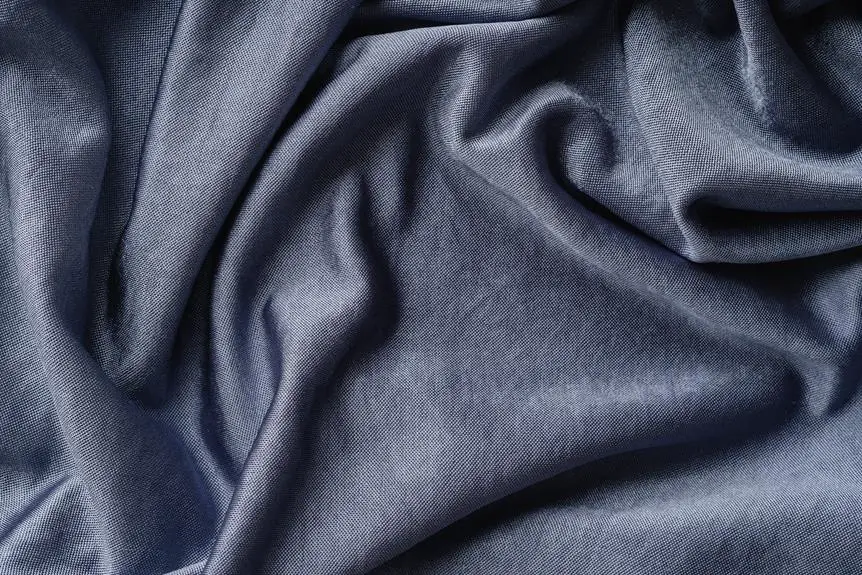Have you ever run your fingers over a rippling stream? That's the kind of smooth, intricate sensation you can expect from twill fabric.
In this exploration of fabric textures, you'll delve into the tactile world of twill weave. From its distinctive diagonal pattern to its sturdy yet supple feel, you'll master the art of identifying twill with confidence.
By comparing it with other textures, you'll gain a nuanced understanding of its unique character. Whether you're a seasoned fabric connoisseur or just starting to appreciate the intricacies of textiles, this journey will deepen your appreciation for the touch and feel of twill.
So, let's embark on this sensory adventure together.
Key Takeaways
- Twill fabric is known for its diagonal weave pattern, which gives it a distinctive texture and drape.
- Twill fabric is durable, wrinkle-resistant, and commonly used in fashion for garments like chinos, jeans, and suits.
- Twill fabric is also favored in home decor for upholstery, draperies, and bedding.
- Twill fabric has a diagonal weave that creates a sense of movement and depth, with raised parallel ribs that provide a refined tactile sensation.
Understanding Twill Fabric
You might be wondering, 'What exactly is twill fabric?'
Well, twill fabric is known for its diagonal weave pattern, which creates a distinctive texture and drape. This unique weaving technique gives twill fabric its durability and wrinkle resistance, making it a popular choice in both fashion and home decor.
In fashion, twill fabric is often used for creating sturdy yet stylish garments like chinos, jeans, and suits. The diagonal lines of twill fabric add an interesting visual element to these clothing items, making them stand out from other fabrics. Additionally, the durability of twill fabric ensures that these garments can withstand regular wear and tear.
In home decor, twill fabric is favored for upholstery, draperies, and bedding due to its strength and versatility. The characteristic diagonal pattern provides a subtle, sophisticated look to furniture and home accessories, making it a popular choice for those seeking a balance of style and durability in their interior design.
Whether in fashion or home decor, twill fabric's unique properties make it a desirable option for those seeking both functionality and aesthetics.
Characteristics of Twill Texture
So, what does twill feel like?
Well, it's all about the unique characteristics of twill texture. The diagonal weave of twill gives it a distinctive look and feel that sets it apart from other fabrics.
Its smooth, durable texture makes it a popular choice for a wide range of clothing and home decor items.
Twill's Diagonal Weave
Feeling the texture of twill fabric, you'll notice its distinct diagonal weave that sets it apart from other fabrics. This unique construction creates a tactile experience that's both visually striking and pleasing to the touch. The diagonal pattern of twill weave gives the fabric a sense of movement and depth, adding an element of sophistication to its texture.
As you run your fingers across twill fabric, you'll feel the raised parallel ribs formed by the weaving technique, creating a subtle sensation of texture that's both refined and durable. This tactile quality not only enhances the visual appeal of twill but also provides a sense of luxury and elegance, making it a popular choice for a wide range of garments and home textiles.
- The diagonal weave offers a sense of movement and depth.
- The raised parallel ribs create a refined tactile sensation.
- Twill's tactile quality enhances its visual appeal.
Smooth, Durable Texture
The smooth, durable texture of twill fabric provides a reliable and resilient feel that is favored for its strength and longevity. When you run your hand over twill fabric, you'll notice a distinct smoothness and a subtle diagonal ribbing effect. This tactile sensation sets twill apart from other weaves, making it a popular choice for a wide range of garments and home textiles. The durability of twill fabric comes from its tight weave and the way it is constructed. This combination of smoothness and durability gives twill its characteristic feel, making it a top choice for items that need to withstand regular use. Check out the table below for a quick summary of the smooth, durable texture of twill fabric.
| Characteristic | Description |
|---|---|
| Smoothness | Distinctly smooth to the touch |
| Durability | Strong and resilient |
| Tactile Sensation | Subtle diagonal ribbing effect |
Sensory Experience of Twill Weave
When you touch twill fabric, you'll notice its diagonal weave pattern, which creates a smooth and sturdy texture. This unique weave is a result of the way the threads are intertwined, giving twill its characteristic diagonal lines.
As your fingers glide over the fabric, you can feel the raised texture of the weave, providing a tactile sensation that's both distinct and appealing. Here's what you can expect when experiencing twill weave:
- Comfort: The diagonal pattern of twill weave creates a soft and luxurious feel against your skin, making it a comfortable choice for clothing and home textiles.
- Durability: The tight weave of twill fabric contributes to its strength and resilience. When you run your hand over twill, you can feel the sturdiness that makes it a durable and long-lasting material.
- Elegance: The tactile experience of twill weave exudes an understated elegance, making it a popular choice for sophisticated apparel and refined home decor.
Exploring the sensory aspects of twill weave enhances your appreciation for its intricate construction and the delightful touch it brings to everyday fabrics.
Comparing Twill With Other Textures
When comparing twill with other textures, you'll find that twill differs from satin in its diagonal weave pattern, resulting in a more textured feel.
If you're looking for a fabric with a distinctive texture, twill might be the one for you.
Let's explore how the unique texture of twill sets it apart from other weaves.
Twill Vs Satin
Comparing twill with other textures, you'll notice a distinct difference in the way satin feels against the skin. Twill is known for its characteristic diagonal weave, which gives it a unique drape and texture. On the other hand, satin boasts a smooth and lustrous surface, often celebrated for its elegant sheen and luxurious feel.
Here's how twill compares with satin:
- Texture: Twill offers a sturdy and structured feel, while satin provides a sleek and silky sensation against your skin.
- Drape: Twill has a more pronounced drape and holds its shape well, while satin drapes fluidly and offers a graceful, flowing effect.
- Sheen: Twill tends to have a matte appearance, while satin's signature feature is its glossy, reflective sheen.
When considering twill vs. satin, understanding these differences can help you choose the perfect fabric for your next project.
Texture Comparison: Twill
Feel the unique texture of twill fabric as it offers a sturdy and structured sensation against your skin, contrasting with other fabric textures. When it comes to fabric comparison, twill stands out for its distinct diagonal weave, which sets it apart from other textiles like satin, plain weave, and herringbone.
The diagonal pattern of twill creates a noticeable texture that's different from the smoothness of satin or the simplicity of a plain weave. Twill's textile feel is characterized by its durability and resilience, making it ideal for garments that require strength and flexibility.
Compared to other textures, twill offers a more substantial and substantial hand feel, giving it a distinctive presence in the world of fabrics.
Touch and Feel of Twill Fabric
To understand the touch and feel of twill fabric, run your fingers along the surface to experience its distinctive diagonal pattern and smooth, durable texture. Twill fabric offers a sensory perception that's both visually and physically appealing. When you touch twill, you'll notice its unique texture that sets it apart from other fabrics. The sensation of twill fabric against your skin evokes a sense of luxury and sophistication, making it a popular choice for clothing and home decor. Its tactile experience is one of resilience and sturdiness, giving you the assurance of its durability.
As you explore the touch and feel of twill fabric, pay attention to its subtle sheen and the way it drapes, creating an elegant and timeless impression.
Emotion-Evoking List:
- The smooth, sleek texture of twill fabric invites a sense of refinement and class.
- Running your fingers across the diagonal pattern of twill evokes a feeling of sophistication and elegance.
- The durable and resilient nature of twill fabric provides a sense of security and longevity.
Practical Applications of Twill Texture
When you incorporate twill fabric into your wardrobe or home decor, you'll experience its versatility and durability firsthand. The practical uses of twill texture are numerous, making it a popular choice for a variety of applications. Here are some examples of how you can make the most of twill fabric in your everyday life:
| Practical Uses | Tactile Experience |
|---|---|
| Clothing | Soft, yet sturdy to the touch |
| Upholstery | Smooth and substantial |
| Accessories | Textured and long-lasting |
| Home Decor | Rich and tactile |
Twill's tactile experience makes it ideal for clothing, providing a soft feel while maintaining durability. When used in upholstery, twill fabric offers a smooth and substantial texture that enhances the overall look and feel of furniture. Accessories made from twill, such as bags and wallets, benefit from its textured and long-lasting nature. In home decor, twill adds a rich and tactile component to items like curtains and throw pillows. These practical applications highlight the tactile beauty and versatility of twill fabric, demonstrating its value in various aspects of daily life.
Caring for Twill Fabrics
Caring for twill fabrics starts with understanding their specific maintenance requirements to ensure their longevity and quality. Twill fabrics are known for their durability and softness, but to maintain these qualities, it's essential to follow proper care instructions.
Here are three key tips for caring for twill fabrics:
- Gentle Washing: To preserve the softness and texture of twill fabrics, opt for a gentle cycle when washing. Use a mild detergent and cold water to prevent damage to the fabric's fibers.
- Avoiding Heat: When drying twill fabrics, avoid high heat as it can cause shrinkage and damage the fabric's texture. Instead, opt for air drying or a low-heat setting to maintain the fabric's softness and shape.
- Ironing with Care: If ironing is necessary, use a low to medium heat setting. Be cautious not to apply too much pressure, as excessive heat and pressure can flatten the characteristic twill weave.
Frequently Asked Questions
Can Twill Fabric Be Used for Outdoor Furniture Upholstery?
Yes, twill fabric can be used for outdoor furniture upholstery. It offers great outdoor durability and fabric performance. You'll also find a variety of color options and the material has longevity.
What Are the Best Types of Garments to Make With Twill Fabric?
Twill fabric is suitable for making durable garments like jeans, chinos, and workwear. Its sturdy weave and durability make it a great choice for creating long-lasting clothing that can withstand regular wear and tear.
Does Twill Fabric Wrinkle Easily?
Twill fabric has good wrinkle resistance, making it a great choice for travel clothing and professional attire. To maintain its appearance, follow proper fabric care instructions, which typically involve machine washing and low-heat ironing.
Are There Any Specific Washing Instructions for Twill Fabric?
For fabric care, you can machine wash twill fabric in cold water and air dry or tumble dry on low. Use a stain remover for tough spots and skip the fabric softener to maintain its texture.
Can Twill Fabric Be Used for Making Curtains or Drapes?
Yes, twill fabric is a great choice for curtains. Its durable, sturdy nature makes it perfect for draping and it also has a subtle texture that adds a touch of elegance to any room.
- What Is Scuba Suede Fabric? - July 12, 2025
- How to Age and Distress Suede Fabric - July 12, 2025
- Is Suede Fabric Good for Curtains? - July 12, 2025







